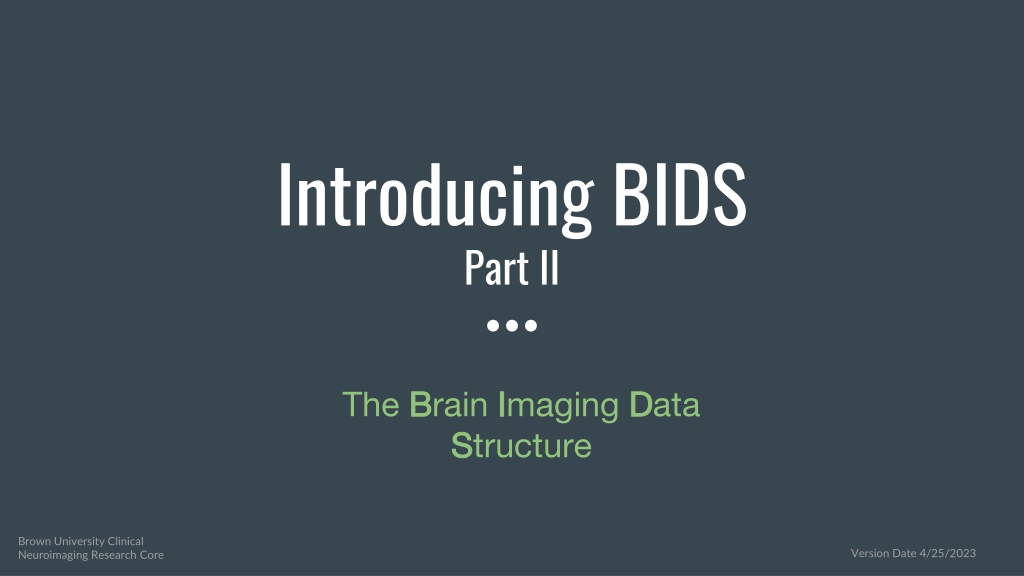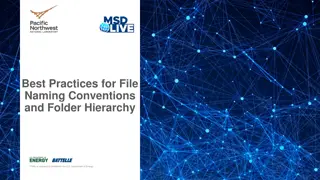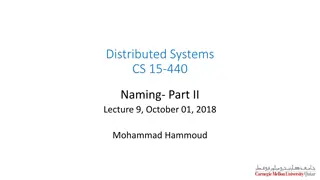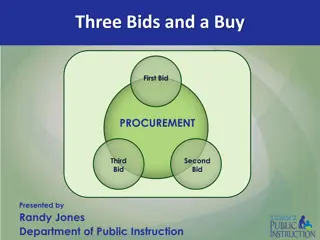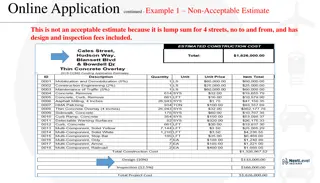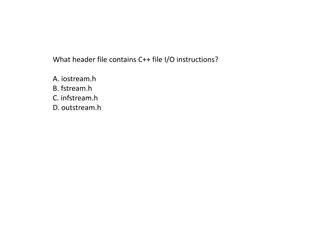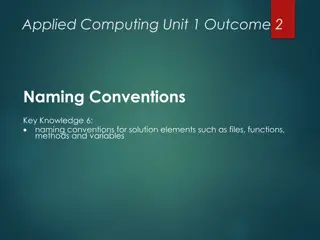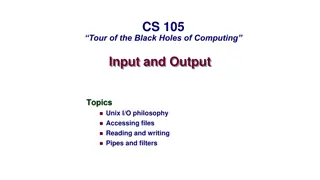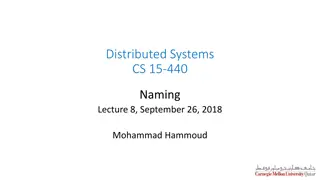Understanding BIDS File Naming Conventions
BIDS (Brain Imaging Data Structure) establishes standardized naming conventions for organizing neuroimaging data. It outlines rules for labeling subjects, sessions, tasks, runs, modalities, and exceptions. The structure helps maintain consistency and facilitates data sharing and collaboration in the neuroimaging research community.
Download Presentation

Please find below an Image/Link to download the presentation.
The content on the website is provided AS IS for your information and personal use only. It may not be sold, licensed, or shared on other websites without obtaining consent from the author. Download presentation by click this link. If you encounter any issues during the download, it is possible that the publisher has removed the file from their server.
E N D
Presentation Transcript
Introducing BIDS Part II The B Brain I Imaging D Data S Structure Brown University Clinical Neuroimaging Research Core Version Date 4/25/2023
BIDS file naming conventions -- subject and session Session field Session field: scans collected together denoted by a two-digit identifier + the prefix ses- . Usually, but not always, defined by separate study visits. Zero pad to two digits Subject field Subject field: a numeric subject identifier + the prefix sub- Zero pad to two digits Ex., -> sub-01 ses-01 = pre-tx scans during Visit 1 before intervention. ses-02 = Visit 1 scans immediately after intervention sub-<##> _ses-<##> ses-03 = scans during Visit 2 following the end of treatment course. sub-01_ses-01_task-nback_run-1_bold.nii.gz
BIDS file naming conventions -- task Task field Task field: a task is a structured set of activities occurring during one data acquisition or run. The task name is appended with task- Task names. Keep them short. BIDS considers resting-state a task. Resting state, task-rest Stop signal reaction time, task-ssrt Applies to functional images _task-<name> sub-01_ses-01_task-nback_run-1_bold.nii.gz
BIDS run and modality naming conventions Run Run: a repeated data acquisition that uses the same scanning parameters and task. Denoted by a two digit numeric identifier + the prefix run- Modality Modality: the category of brain data recorded in a file. Different MRI pulse sequences are considered distinct modalities Do not zero pad MRI: T1w, bold, dwi Optional if acquisitions are not repeated T1w (anatomical), bold (functional), dwi (diffusion weighted) Example -> run-1 Passive recordings: eeg, meg, ieeg _<modality> _run-<#> sub-01_ses-01_task-nback_run-1_bold.nii.gz
BIDS exceptions and references Suffix File extension This compressed your file into a smaller size to decrease the amount of memory for storage Some programs require unzipped files To unzip type the following into your command line gzip -d <name of file> To rezip type gzip <name of file> Describes that the file is a nifti file A behavioral data might be .tsv, .csv or .txt EEG data would be .edf or .set nii sub-01_ses-01_task-nback_run-1_bold.nii.gz gz
Other BIDS Examples MRI sub-01_ses-01_task-ssrt_run-1_bold.nii.gz sub-01_ses-01_T1w.nii.gz EEG sub-01_ses-01_task-provac_run-2_eeg.edf Behavioral sub-01_ses-02_task-ssrt_run-2_beh.csv subject_session_task_run_modality.suffix
BIDS exceptions and references BIDS is evolving, standards aren t set for some data types o Positron Emission Tomography (PET) o Computed Tomography (CT) o Spectroscopy o Eye Tracking Data Non-compliant files can cause problems for analysis platforms that automatically perform BIDS validation Datasets with non-compliant files are tagged as invalid and generate errors, especially with data pipelines Including a BIDS ignore text file in your directory can help See next slide for details
How to make a .bidsignore file Name the file .bidsignore Save it in the rawdata folder This file tells the BIDS validator or other programs that use bids to certain files that do not follow BIDS structure **/*errors* tells programs to ignore any file containing the word errors in its name Uses wildcards * to allow for generalizability
Exercises - Part 1 Create a name for a stop signal reaction time task for a subject (3221). When doing so, add the following components for the BIDS file name Session number two The task will be a stop signal reaction time task This will be the second run The modality involves a bold recording Use the required suffix and file extension Example Create a name for a Stroop task for a subject (2716). When doing so, add the following components for the BIDS file name Session number one The task will be a Stroop task This will be the first run The modality involves a T1w recording Use the required suffix and file extension sub-001_ses-01_task-nback_run-1_bold.nii.gz
Exercises - Part 2 Below are a list of data types Place an X on the data types that are not compliant with BIDS. Hint: There are three. Positron Emission Tomography (PET) Functional Magnetic Resonance Imaging (fMRI) Electroencephalogram (EEG) Eye Tracking Data Magnetoencephalography (MEG) Computed Tomography (CT)
For further guidance Check out the BIDS Specification website and the manual for more guidance BIDS Manual For a comprehensive review https://zenodo.org/record/4710751#.YSPUrNNKj9B Please refer to pages 150 - 161 for common data types that are often utilized in BIDS. BIDS Data Reference Guide For a quick start reference https://bids-specification.readthedocs.io/en/stable/04-modality-specific-files/01- magnetic-resonance-imaging-data.html Please refer to the extension proposals page for further inquiry on types of data that are currently not compatible with BIDS. BNC BIDS Guide https://docs.ccv.brown.edu/bnc-user-manual/bids/introduction-to-bids
